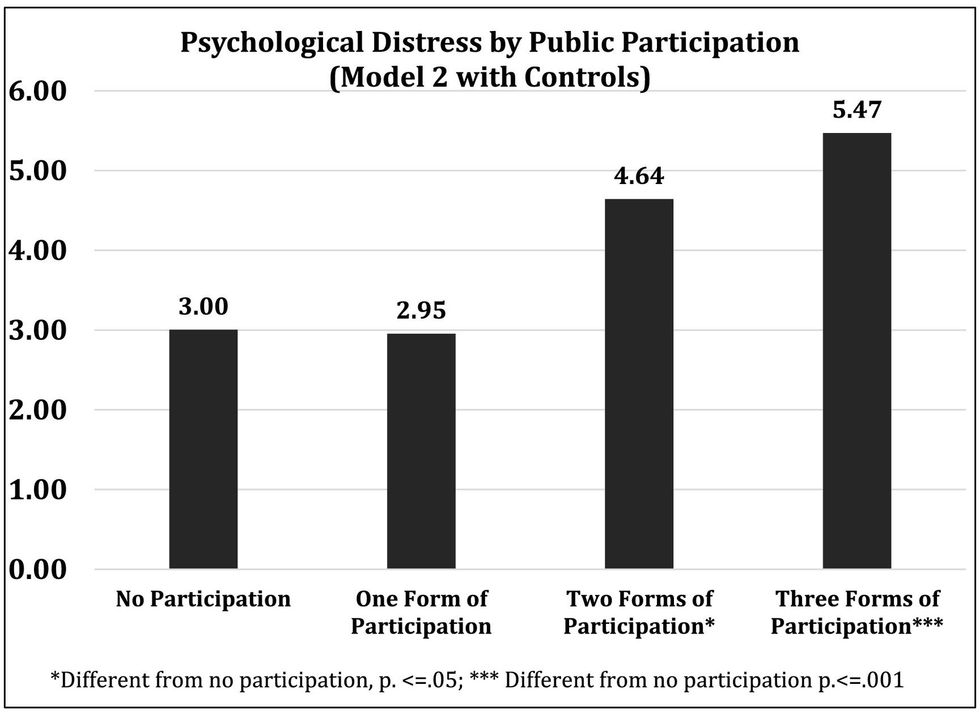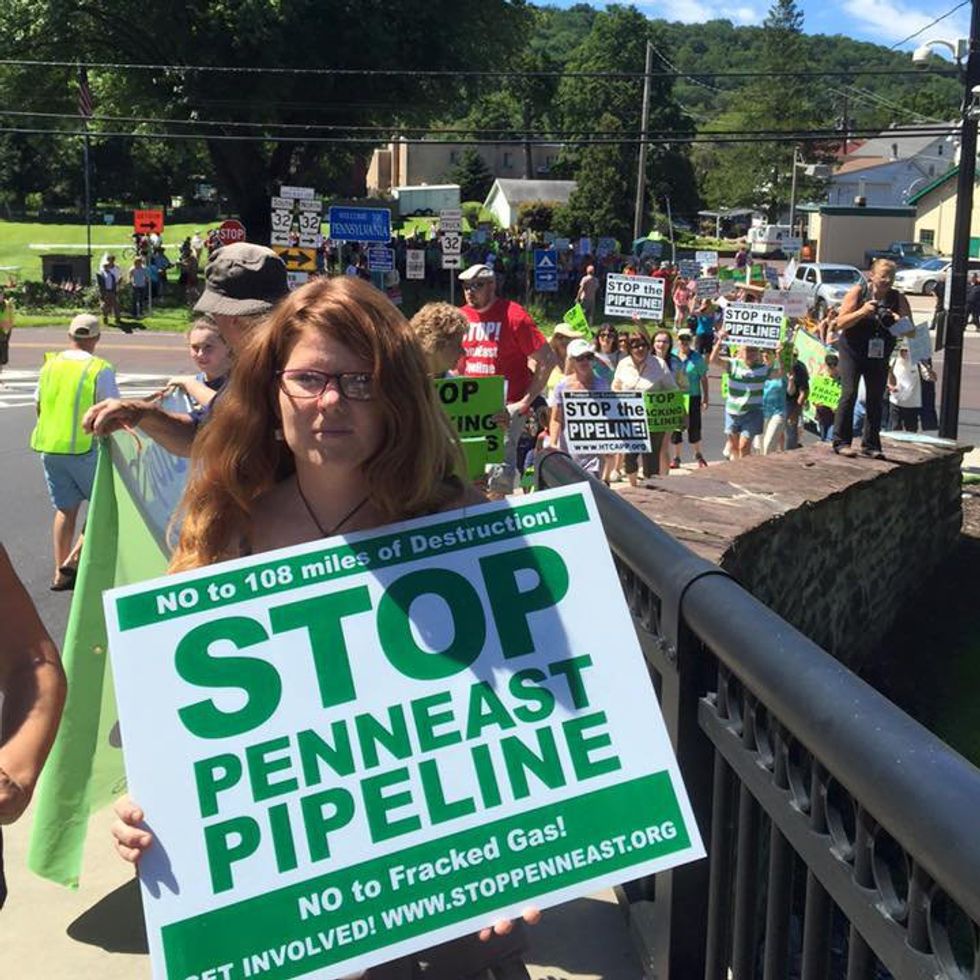
PITTSBURGH — Engaging in public participation during permitting for oil and gas pipelines often harms mental health and creates distrust in government, according to a new study.
Numerous studies have examined physical health effects associated with living near oil and gas pipelines, but there’s little research on the mental health impacts associated with these projects.
The study, published in Energy Research & Social Science, was conducted through surveys and interviews with more than 1,000 people living near proposed natural gas pipelines in Virginia, West Virginia, Oregon and Pennsylvania. It documented a long list of mental health symptoms associated with living near pipeline routes, including anxiety, depression, Complex post-Traumatic Stress Disorder (CPTSD) and suicidality.
“I live in Blacksburg, Virginia, which is one of the places the Mountain Valley Pipeline goes through,” Shannon Bell, a professor of sociology at Virginia Tech and lead author of the study, told Environmental Health News (EHN). “In conversations with community members who are affected by the pipeline, it became very clear there were some pretty significant traumas going on.”
By using screening tools to measure the severity of mental health symptoms, the researchers also determined that the more people engaged with public participation processes related to the pipelines, the worse their mental health impacts were.
“Having a pipeline built through your land is incredibly stressful for many people, but we were surprised to learn that the people who were the most engaged in public participation processes related to the pipeline had significantly greater mental health impacts than people who didn’t engage at all, regardless of whether the pipeline was actually being constructed through their land,” Bell said.
Karen Feridun, an activist who lives in eastern Pennsylvania, has fought two pipeline projects, the PennEast and Commonwealth pipelines, both of which were canceled following community resistance. She’s proud of those wins, but they were difficult for her and the community.
“The PennEast fight went on for seven years,” Feridun told EHN. “People were so dedicated. It was like they made fighting the pipeline their second full time job. Many people expressed how stressed this made them feel, the pain of seeing their property devalued and their beautiful community disrupted, and how unending it all was. It was a lot to endure.” stories like that.”

When the Commonwealth and PennEast pipelines were canceled, Feridun said, there was a lot of relief. “The state of everybody’s mental health improved to the extent that this was over and they could move on with their lives,” she said. However, many of the Pennsylvanians involved in those fights were soon faced with additional oil and gas-related projects in their communities, like fracking wells or related infrastructure, pulling many of them right back into fight mode.
“There’s this constant pressure and feeling of powerlessness that comes with not knowing what’s about to happen,” Feridun said. “For some people it just starts to feel like a never-ending nightmare.”
Bell’s study found that pipeline development and related public participation processes were associated with a long list of physical symptoms including insomnia, high blood pressure, heart problems, teeth grinding, headaches, tremors, irregular heartbeat, shingles, heart problems, chest pain, strokes and brain hemorrhages. At least one person said they were so physically sickened by the stress they felt about the pipeline and the public participation process that they had to move.
“The number of stress-activated health conditions people reported was quite staggering,” Bell said. “It was devastating to read some of the things people had gone through.”
Feridun shared a story about a community member who protested a FERC meeting and had a stroke afterwards. “The family’s feeling was that the pressure she was under contributed to her having a stroke at a very young age,” she said. “There were lots of stories like that.”
Performative public participation creates harm
Bell researched the National Environmental Policy Act (NEPA), passed in 1969, which heightened the public involvement requirements for federal agencies' decision-making on actions that could significantly affect the environment.
She found previous research that suggested NEPA’s public participation requirements are only intended to diffuse public outrage since government agencies don’t have standardized ways to incorporate public input into decision-making or permitting.
She also learned that the Federal Energy Regulatory Commission (FERC), the agency responsible for regulating pipelines, approved 99% of eminent domain cases between 1999 and 2020, allowing pipelines to be built through privately owned land despite widespread public opposition to many of these projects.
"Many people expressed how stressed this made them feel, the pain of seeing their property devalued and their beautiful community disrupted, and how unending it all was. It was a lot to endure.” - Karen Feridun, an activist who lives in eastern Pennsylvania
Other researchers had highlighted the flaws in NEPA’s public participation requirements and FERC’s apparent bias against landowners, but no one had measured how participating in performative public participation processes impacts residents’ mental health.
Bell and colleagues found that people who participated in these processes felt their input was dismissed, that their concerns were not addressed and did not have any impact on decision-making about the pipelines.These feelings created disillusionment and distrust. The more people participated in public feedback processes, the stronger their feelings of disillusionment were.
“Many people talked about feeling betrayed by their government,” Bell said. “A number of our respondents stated that up until this point, they had believed government agencies existed to protect residents. But after spending tremendous amounts of time engaging in public input opportunities, many of our respondents came to believe that these government agencies were actually just there to facilitate the construction of pipelines.”


Feridun has seen this firsthand.
“In all my years fighting pipelines and fracking,” she said, “I’ve heard so many people say: ‘I thought the government was here to protect me,’ and it comes as this terrible blow to learn they’re actually representing someone else’s best interest, not yours.”
Bell’s research focused on natural gas pipelines, but she said these findings are relevant to any scenario where government agencies invite public participation during the permitting process for industrial projects. For example, permitting for fracking wells and petrochemical plants are often contentious and generally overseen by state regulatory agencies that may invite public input but also typically lack any ways to incorporate it into permitting decisions.
“People aren’t stupid — they realize when their comments aren’t making a bit of difference,” Bell said. “It’s incredibly disempowering when people spend hours and days writing public comments and attending public meetings, just to be ignored.”
“I don’t want to beat up on regulators because this is an institutional problem,” she added, “but wasting people's time and energy by asking for public input without providing a mechanism to act on most of their concerns not only brings substantial harm to these individuals' mental and physical health, but it also violates core aspects of environmental justice."
Feridun said that although she tells people joining pipeline fights that public participation is “just theater and a box regulators have to check,” there are important reasons to participate anyway.
The first is that pipeline route often travel through rural areas where impacted landowners feel isolated and alone in their discomfort about the pipeline, and joining with others who are in the same situation creates strong community bonds and fosters empowerment. During the PennEast fight, for example, municipalities all along the proposed pipeline route passed resolutions stating their opposition to the pipeline. Those could be ignored by FERC, but they made it clear in writing that many communities along the pipeline route were prepared to fight the project in court if needed.
The second reason Feridun encourages people to participate in the permitting process is that even if FERC won’t do anything with public comments, it’s critical to put them in the public record so that a judge can consider them in subsequent lawsuits, which can be a powerful tool in winning pipeline fights.
“That’s part of how we won against PennEast,” she said. “People put so many comments on that docket, they were relentless … and gave lots of ammunition to judges who might one day have to consider those lawsuits.”
No environmental justice without real public input
Under guidance from the Biden presidential administration, federal and state governmental agencies are working to improve environmental justice.
Many states, including Pennsylvania, are developing new environmental justice plans that include additional community input related to permitting for polluting industries, but Bell said few of these plans create ways for environmental justice communities to influence permitting decisions (though there are some indications that this is beginning to shift).
Traditionally, governmental environmental justice efforts in the U.S. tend to focus on “distributive justice” — ensuring equity in the allocation of burdens and benefits. But the principles of environmental justice also include recognition justice, which entails valuing the perspectives of historically marginalized groups; procedural justice, which involves providing these communities with equitable access and opportunities to influence decision-making; and reparative justice, which requires acknowledging past harms against these communities and working to repair them.
Environmental justice communities can’t achieve procedural justice or restorative justice until they’re actually empowered to decide whether new pipelines or polluting facilities should be built in their neighborhoods, according to Bell.
“Environmental justice is not possible if public participation is performative,” Bell said. “If we’re serious about environmental justice, there need to be consistent [ways] for public input to be incorporated into agencies' decision-making processes. It needs to be possible for public input to actually influence agency decisions."

 2 months ago
32
2 months ago
32


